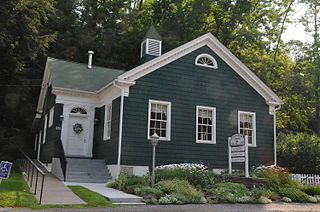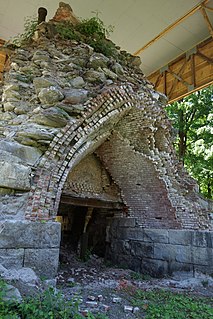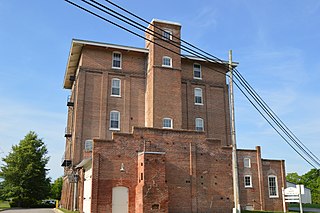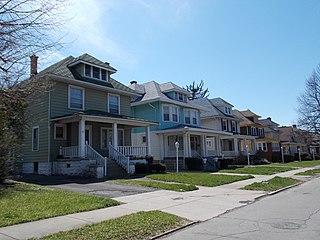
This is intended to be a complete list of properties and districts listed on the National Register of Historic Places in Orleans County, New York. The locations of National Register properties and districts may be seen in a map by clicking on "Map of all coordinates". Two listings, the New York State Barge Canal and the Cobblestone Historic District, are further designated a National Historic Landmark.

There are 73 properties listed on the National Register of Historic Places in Albany, New York, United States. Six are additionally designated as National Historic Landmarks (NHLs), the most of any city in the state after New York City. Another 14 are historic districts, for which 20 of the listings are also contributing properties. Two properties, both buildings, that had been listed in the past but have since been demolished have been delisted; one building that is also no longer extant remains listed.
The Maplewood Historic District is located in Rochester in Monroe County, New York. The district is distinguished as having landscape designs, including Maplewood Park, originally laid out by Frederick Law Olmsted.

Forest Home Historic District is a national historic district located at Forest Home in Tompkins County, New York. The district consists of 66 contributing buildings, four contributing sites, and two contributing sites. The historic building stock consists primarily of one- to two-story frame dwellings on relatively small, irregularly shaped lots.

Copake Iron Works Historic District is a national historic district located at Copake Falls in Columbia County, New York. The district includes 11 contributing buildings, three contributing sites, eight contributing structures, and three contributing objects. They are associated with the remaining vestiges of the Copake Iron Works, an iron extraction and production operation established in the mid-19th century. It includes the remains of a charcoal blast furnace, frame office and attached brick powder storage building, brick engine house and pattern shop, four frame workers houses, and a substantial Greek Revival dwelling. Also included in the district are a series of retaining walls, remnants of a cast-iron penstock, and a bridge abutment. Also located in the district is the previously listed Church of St. John in the Wilderness.
Stuyvesant Falls Mill District is a national historic district located in the town of Stuyvesant in Columbia County, New York. The district includes six contributing buildings, five contributing sites, and two contributing structures. They are the industrial sites and power sources from which the adjoining village of Stuyvesant Falls derived its livelihood. It includes the Upper and Lower Falls and mill dams; on the east bank of Kinderhook Creek the sites of a grist mill and paper mill, cotton mill, woolen mill complex and extant hydroelectric plant; west bank operations including three extant 19th century cotton mills and several dwellings. Also included is an iron truss bridge erected in 1899.

Ironville Historic District is a national historic district located at Ironville in Essex County, New York. The district contains 12 contributing buildings. It encompasses the area associated with a once thriving iron works. Almost nothing remains of the iron works itself. The remaining buildings consists of modest wooden dwellings including the Penfield Homestead, boarding house (1827), Congregational Church (1842), commercial building / grange hall (1870s), and cemetery. Ironville is known as the "Birthplace of the Electrical Age", being the site of the first industrial application of electricity in the United States.

The Downtown Morgantown Historic District is a federally designated historic district in Morgantown, Monongalia County, West Virginia. The district, encompassing approximately 75 acres, has 122 contributing buildings and 2 contributing sites including commercial and public buildings, residences, and churches. The district has been listed on the National Register of Historic Places since May 2, 1996. Ten of the contributing buildings are listed separately on the National Register of Historic Places. Significant structures located within the historic district are the Monongalia County Courthouse, the Metropolitan Theater, and the Old Morgantown Post Office.

Moxham Historic District is a national historic district located at Johnstown in Cambria County, Pennsylvania. The district includes 330 contributing buildings in a predominantly residential area in southern Johnstown. There are 315 contributing dwellings, 17 former carriage house / horse barns, 21 commercial buildings, 10 churches, and one former school. The district includes five contributing buildings dated before the Johnstown Flood, but the majority date from 1890 to 1930. The dwellings include notable examples of popular architectural styles including Bungalow/craftsman, Colonial Revival, and American Foursquare. Notable non-residential buildings include St. Patrick's Catholic Church (1905), former Calvary Methodist Church (1894), Allegheny Wesleyan Methodist Church (1898), Grove Avenue Methodist Church (1902), Second Presbyterian Church (1914), and former Cypress Avenue School (1900).
Glen Rock Historic District is a national historic district located at Glen Rock in York County, Pennsylvania. The district includes 287 contributing buildings, 1 contributing site, and 4 contributing structures in the central business district and surrounding residential area of Glen Rock. The houses are mostly 2+1⁄2-story, vernacular wood-frame buildings, built between 1838 and 1945, with some notable Queen Anne and Bungalow/craftsman style dwellings. Notable buildings include the Philip Shaffer House, the "Castle" (1889), Peoples Bank of Glen Rock (1912), Glen Theatre (1913), Glen Rock Hose and Ladder Company (1904), Zion Evangelical Lutheran Church (1905), Immanuel United Methodist Church (1926), Industrial Sewing Company (1916), Glen Traditionals building (1921), and Accufab building. A contributing structure is the Northern Central Railway bridge.

Upper Roxborough Historic District is a national historic district located in Philadelphia and Whitemarsh Township, Montgomery County, Pennsylvania. It encompasses 108 contributing buildings, 23 contributing sites, and 18 contributing structures in Upper Roxborough. The district includes a number of small scale farm and industrial workers' housing, estate houses, mill-owners' dwellings, and farm buildings. Notable buildings include the Shawmont Railroad Station (1834), Miquon Station designed by Frank Furness (1910), Riverside Paper Mills, Hagy's Mill ruin, St. Mary's Church, and "Fairview" and other buildings on the grounds of the Schuylkill Center for Environmental Education. The Roxborough Pumping Station was also part of the district, but it was demolished in 2011 after sitting abandoned for over fifty years.
This is a timeline and chronology of the history of Brooklyn, New York. Brooklyn is the most populous of New York City's boroughs, and was settled in 1646.

The Aurora Highlands Historic District is a national historic district located at Arlington County, Virginia. It contains 624 contributing buildings, 2 contributing sites, and 1 contributing structure in a residential neighborhood in South Arlington. Aurora Highlands was formed by the integration of three subdivisions platted between 1896 and 1930, with improvements in the form of modest single-family residences. The district is characterized by single family dwellings with a number of twin dwellings and duplexes, three churches, a rectory, two schools, two landscaped parks, and commercial buildings. The oldest dwelling is associated with “Sunnydale Farm” and is a Greek Revival-style dwelling built about 1870. The predominant architectural style represented is Colonial Revival.

Edenton Cotton Mill Historic District is a national historic district located at Edenton, Chowan County, North Carolina. The district encompasses 70 contributing buildings, 1 contributing site, 2 contributing structures, and 1 contributing object in a small mill village. It includes industrial and residential buildings developed between 1899 and 1923. Residential buildings are primarily simple one-story, single-pile, frame dwellings and some examples of the Bungalow / American Craftsman style. Notable non-residential buildings include the Italianate Revival style Edenton Cotton Mill (1899-1916), Edenton Cotton Mill Office, and First Christian Church (1916).

Mount Vernon Triangle is a neighborhood and community improvement district in the northwest quadrant of Washington, D.C. Originally a working-class neighborhood established in the 19th century, present-day Mount Vernon Triangle experienced a decline in the mid-20th century as it transitioned from residential to commercial and industrial use. The neighborhood has undergone significant and rapid redevelopment in the 21st century. It now consists mostly of high-rise condominium, apartment and office buildings. Several historic buildings in the neighborhood have been preserved and are listed on the National Register of Historic Places. Mount Vernon Triangle is now considered a good example of urban planning and a walkable neighborhood.

Hamlin Park Historic District is a national historic district and neighborhood located at Buffalo in Erie County, New York. The district encompasses 1,368 contributing buildings, 3 contributing sites, and 6 contributing structures in a predominantly residential section of Buffalo. The district includes a variety of residential buildings built primarily between about 1895 and 1930, and later improved through Model Cities Program grants between 1966 and 1975. It includes a variety of pattern book houses in popular architectural styles of the late-19th and early-20th century, with some interspersed Bungalow / American Craftsman style dwellings. Located in the district are the separately listed Robert T. Coles House and Studio and Stone Farmhouse. Other notable buildings include the Lutheran Church Home (1906), the former Second United Presbyterian Church (1920), and the former St. Francis DeSales Roman Catholic Church (1926).

Sibley–Elmdorf Historic District is a national historic district located at Rochester, Monroe County, New York. The district encompasses 840 contributing buildings and 1 contributing site in a predominantly residential section of Rochester. The district developed between about 1904 and 1963, and includes buildings in a variety of architectural styles including Classical Revival, Colonial Revival, Gothic Revival, Tudor Revival, Mission Revival, American Foursquare and Bungalow / American Craftsman. The dwellings reflect designs directed toward a middle-class clientele in a newly developing area of Rochester's Nineteenth Ward. Located in the district is the Westminster Presbyterian Church, West High School by Rochester architect J. Foster Warner, Walter Spencer Public School #16, and Aberdeen Square Park.

The Davenport Downtown Commercial Historic District is a nationally recognized historic district located in the central business district of Davenport, Iowa, United States. It was listed on the National Register of Historic Places in 2020. At the time of its nomination it consisted of 43 resources, which included 33 contributing buildings, one contributing structure, and nine non-contributing buildings. In addition, the district also contains 33 buildings that are individually listed on the National Register. This historic district is bordered by four other districts: the Crescent Warehouse Historic District and the Davenport Motor Row and Industrial Historic District on the east, the Hamburg Historic District to the northwest, and the West Third Street Historic District on the west.

Old Bridge, also known as the Historic Village of Old Bridge, is an unincorporated community located within East Brunswick in Middlesex County, New Jersey. It is on the South River, a tributary of the Raritan River. The community is named after the first bridge built here to cross the river, the South River Bridge. After other bridges were built crossing the river, it became known as the Old Bridge. The Old Bridge Historic District, encompassing much of the village, is listed on the state and national registers of historic places.



















